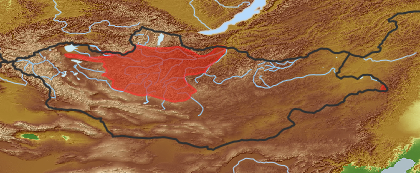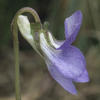| Class: | angiosperms |
| Order: | Asparagales |
| Family: | Orchidaceae |
| Genus: | Dactylorhiza |
| Scientific name: | Dactylorhiza incarnata (L.) Soo |
| Name acc. to: | Gubanov 1996, not in Grubov 1982/2001 |
| open map in a new window |  |
| Habitat: | In wet and swampy meadows, along banks of water reservoirs (Flora of Siberia, Vol. 4, 2001). |
| Habit (i)general appearance of a plant | |
| Parasite status: (i)Is the plant a half- or full parasite? | no parasite/saprophyte (i)Plant fully autonomous, leaves with chlorophyll
example: Most plants, Ranunculus  inherited by genus Dactylorhiza: no parasite/saprophyte inherited by genus Dactylorhiza: no parasite/saprophyte
|
| Water or terrestrial plant: (i)Where do the plants grow? | terrestrial (i)Plant grows on dry land
example: Orostachys spinosa  inherited by family Orchidaceae: terrestrial inherited by family Orchidaceae: terrestrial
|
| Leaf (i)expanded, usually photosynthetic organ of a plant (including phylloclades) | |
| Leaf development: (i)Structure and development of leaves. | flattened blade (i)Cross-section of lamina flat, plain  inherited by genus Dactylorhiza: flattened blade inherited by genus Dactylorhiza: flattened blade
common leaf (i)Green, often divided in blade and petiole
example: Cotoneaster  inherited by genus Dactylorhiza: common leaf inherited by genus Dactylorhiza: common leaf
with green leaves (i)Plant with green leaves  inherited by genus Dactylorhiza: with green leaves inherited by genus Dactylorhiza: with green leaves
|
| Leaf arrangement: (i)Arrangement of leaves at the stem. | alternate (i)One leaf per node; distiche: arranged in two vertical rows, equitant
example: Phragmites    inherited by family Orchidaceae: alternate inherited by family Orchidaceae: alternate
basal rosette (i)Leaves positioned at the base of the stem; stem often without leaves, no visible internodes (but flowers often on erect stems, and these may have few leaves)
example: Limonium, Potentilla, Plantago; also used in Liliales with basaly crouwded leaves (Tofieldia, Zigadenus etc.)   inherited by family Orchidaceae: basal rosette inherited by family Orchidaceae: basal rosette
|
| Simple or divided leaves: (i)Are the leaves simple or completely divided in several parts? Blade of the leaf entire or (more or less) deeply dissected. Attention: There are various appearances of the leaf margin (from entire to toothed and lobed). Here, we ignore this and ask only for dissections that separate the leaf for more than one third of its length or width, whatever is smaller. Sometimes, it is difficult to tell apart compound leaves from a shoot system with simple leaves: look for stipulae and/or axillary buds at the ground of the leaves: if only some possess these structures, the others are most likely leaflets of a compound leaf. | simple (i)Non-divided leaf, but margin may be incised nearly to the ground   inherited by family Orchidaceae: simple inherited by family Orchidaceae: simple
|
| Leaf margin: (i)Structure of leaf margin (or that of a leaflet in case of compound leaves). Attention: Here we ask for the leaf margin, defined as all those dissections that separate the leaf for less than one third of its length or width, whatever is smaller. To be worked out: how to handle margin of pinnate leaves? | entire (i)Plain margin, not toothed
example: Iris   inherited by family Orchidaceae: entire inherited by family Orchidaceae: entire
|
| Leaf veination: (i)Arrangement of the main veins of a leaf. | parallel (i)Most veins arranged parallel to the length of leaf, mostly no pronounced main vein (usually in elongate to linear leaves)
example: Most Monocotyledonae, Plantago, Veratrum, a lot of Caryophyllaceae looks like that.   inherited by order Asparagales: parallel inherited by order Asparagales: parallel
|
| Flower (i)reproductive portion of the plant, consisting of sepals, petals, stamens, and pistils | |
| Flower appearance and pollination: (i)General appearance of the flower. | attractive, animal-pollinated (i)attractive and coloured flowers, mostly large, attracting surely animals
example: Trollius, Rosa, Chamaerhodos  inherited by family Orchidaceae: attractive, animal-pollinated inherited by family Orchidaceae: attractive, animal-pollinated
|
| Perianth arrangement: (i)Attention: in some plants, flowers may be dimorphic in different ways (dioecious or gynodioecious). If flowers vary, record the characters of the most showy flowers. | double, different (i)Two types of perianth leaves, differently coloured (sepals: outer periant leaves, usually greenish, and petals: inner perianth leaves, usually coloured)
example: Parnassia    inherited by family Orchidaceae: double, different inherited by family Orchidaceae: double, different
|
| Flower symmetry: (i)Symmetry of the perianth leaves. Attention: to assess this character, look on sepals, petals and stamens, but neglect carpels and ovary. | zygomorphic (i)One axis of symmetry, monosymmetrical flowers
example: Pedicularis, Nepeta, Viola     inherited by family Orchidaceae: zygomorphic inherited by family Orchidaceae: zygomorphic
|
| Petal / Tepal number: (i)Number of petal leaves (inner perianth leaves, usually coloured). | 6 (i)
example: Allium, Lilium, Dactylorhiza  inherited by family Orchidaceae: 6 inherited by family Orchidaceae: 6
|
| Petal / Tepal fusion: (i)To which degree are the petal leaves connected? Petals sympetalous. | fused (i)petal leaves united, only tips are free (gamopetalous, sympetalous)
example: Linnaea, Adenophora, Stellera  inherited by family Orchidaceae: fused inherited by family Orchidaceae: fused
|
| Spur: (i)A hollow, slender, sac-like appendage of the perianth leaves, storing nectar. | one (i)One leaf with a spur
example: Linaria, Delphinium    inherited by genus Dactylorhiza: one inherited by genus Dactylorhiza: one
|
| Stamen number: (i)Attention: We ask for the reproductive organs of the flower dispersing pollen. Count only fully fertile stamens, not staminodia (e.g. Parnassia). | 1 (i)
example: Orchis  inherited by family Orchidaceae: 1 inherited by family Orchidaceae: 1
2 (i)
example: Cypripedium  inherited by family Orchidaceae: 2 inherited by family Orchidaceae: 2
|
| Stamen fusion: (i)To which degree are the stamens fused? Attention: Whereas the pollen sacs itself are often free., their stalks (filaments) may be fused. Here, we count them as fused if they are together over at least one thirth of their length. | fused with each other (i)All or most stamens fused with each other to a tube-like structure
example: Caragana, Petasites  inherited by family Orchidaceae: fused with each other inherited by family Orchidaceae: fused with each other
|
| Carpel fusion: (i)To which degree are the carpels (modified leaf forming simple pistil or part of a compound pistil) fused. | fused (i)Carpels united into an ovary, only styles are free
example: Malus, Berberis  inherited by family Orchidaceae: fused inherited by family Orchidaceae: fused
|
| Style number: (i)Portion of the pistil connecting the stigma to the ovary. | 1  inherited by family Orchidaceae: 1 inherited by family Orchidaceae: 1
|
| Ovary position: (i)For entirely or partly fused carpels, describe their position in relation to the insertion point of perianth leaves (best done by doing a longitudinal section of a flower). | inferior (i)Ovary below the point where perianth leaves are inserted, always fused to an ovary
example: Vaccinum    inherited by family Orchidaceae: inferior inherited by family Orchidaceae: inferior
|
| Fruit (i)the seed bearing organ, with or without adnate parts; a ripened ovary and any other structures which are attached and ripen with it. Aggregate fruits are handled like simple fruits for determination. | |
| Type of fruit: (i)Common fruit types (including pseudocarp). | Solitary fruits (i)     inherited by family Orchidaceae: Solitary fruits inherited by family Orchidaceae: Solitary fruits
capsule (i)Dry dehiscent fruit, releasing seeds by slits or holes.
example: Poppy, most Caryophyllaceae, Cerastium, a lot of Scrophulariaceae, Iris (oppened capsule looks like Delphinium), Zygophyllum - it is a very common fruit type     inherited by family Orchidaceae: capsule inherited by family Orchidaceae: capsule
Dehiscent fruits (i)Fruits open along a longitudinale line (except silicula)  inherited by family Orchidaceae: Dehiscent fruits inherited by family Orchidaceae: Dehiscent fruits
|
| Seed number: (i)Estimate the number of seeds per fruit, if recognizable seeds are in the fruit (in rare cases a fruit may contain one seeded nuts: rose hip, carex). | >50 (i)Innumerable, impossible to count (usually very fine seeds)
example: Papaver: many-seeded capsule, Hesperis: many-seeded siliqua  inherited by family Orchidaceae: >50 inherited by family Orchidaceae: >50
|
| Root / shoot below ground (i)plant part below ground (in most cases), including below ground shoots, without leaves | |
| Root type: (i)Organisation of the roots. | homorhizous (i)Many equal roots
example: Monocotyledonae  inherited by order Asparagales: homorhizous inherited by order Asparagales: homorhizous
|
| Runners: (i)Plant must be excavated; shoots, subterranean shoots connected by runners. | none (i)No runners or stolos visible
example: Dactylorhiza  inherited by genus Dactylorhiza: none inherited by genus Dactylorhiza: none
|
| Distribution (i)region where the plant is likely to be found | |
| Distribution (Veg. Zones): (i)acc. to Grubov 1952 | Khangai (i)In distribution data often named as '3' 
Great Khingan (i)In distribution data often named as '5' 
acc. to: Gubanov 1996 |